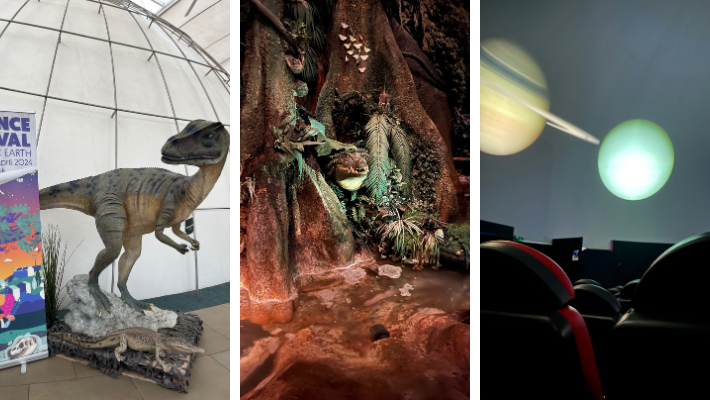It had been a while since we visited Dynamic Earth, but with the cousins up for a visit (and with the rain pouring down) we decided it would be the perfect rainy day spot in Edinburgh for kids. My eldest nephew loves nature and I knew that the immersive experience of Dynamic Earth would undoubtably catch his interest. It’s always full of exciting activities for children – and with a 5 year old, two 8 year olds, and an 11 year old to entertain – it is another one that is good for kids of all ages! Perfect for the Easter holidays or any time it’s raining… which is basically any time of the year!
A Dynamic Discovery Journey
Dynamic Earth is an unparalleled educational experience that takes visitors on a journey through the history of our planet, from its inception to the present day. As we embarked on our adventure, memories of past Geography lessons flooded back, and I found myself immersed in the interactive exhibits alongside my children.
Interactive Learning for All Ages
One of the most impressive aspects of Dynamic Earth is its interactivity. While there are traditional exhibits with informative displays, the majority of the experience is hands-on, allowing children to engage with the material in a tangible way. From exploring how rocks change under pressure to feeling the texture of a real iceberg, the exhibits at Dynamic Earth spark curiosity and excitement in learners of all ages.

Sensory Exploration and Live Narration
During our visit, we were treated to a multi-sensory journey through various themed rooms, each offering a unique experience. From simulated earthquakes to 4-D adventures with wind and snow, Dynamic Earth captivated our senses at every turn. The highlight for us was the planetarium film, narrated live by an actual astronomer. As we reclined and gazed up at the 360-degree dome, we were transported to distant galaxies and learned about the wonders of the universe in real-time.

Easter Holidays and Science Festival Fun
If you’re planning a visit during the Easter holidays, be sure to check out the Edinburgh Science Festival, which coincides with our trip. While the festival offers a few additional activities, the main attraction remains the tour of Dynamic Earth itself. With its blend of education and entertainment, Dynamic Earth is the perfect destination for families seeking adventure and discovery.

Tips for a Seamless Visit
Before you embark on your Dynamic Earth adventure, here are a few tips to ensure a smooth and enjoyable experience:
- Plan your journey in advance, especially if traveling by car. Parking can be pricey in Edinburgh, so consider alternative transportation options. There is a car park below Dynamic Earth with a lift straight up into the museum but it is also well served by bus links.
- Take advantage of meal deals and season tickets to save money on admission and dining. Near by cafe – The Levels – is a good spot if you’d like to avoid the echo of the main auditorium at Dynamic Earth.
- Don’t forget to bring a baby sling if you have young children. While Dynamic Earth offers a sensory-rich experience, it may be overwhelming for some infants.
- Sensory bags are available visitors which include some ear defenders and fidget toys – just ask one of the many attendants there. But it took a while for them to find one and there is a lot of noise in the holidays, so perhaps plan ahead and take your own.
To plan your visit to Dynamic Earth, I would always advise booking ahead – Adult admission is £19 and Child Admission is £12 – although under 4s are free! This includes a Planetarium visit and you’ll be prompted to book a time slot when you buy your ticket. It’s worth noting that you can buy a planetarium visit separately – tickets are £7.70 for both adults and children. The show lasts around 30 minutes and there’s an opportunity to ask questions to the astronomer afterwards!


